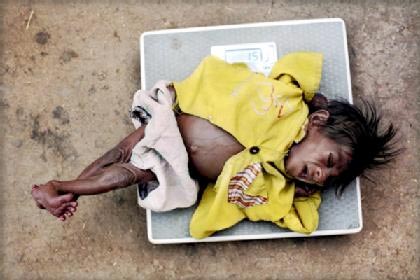The Hidden Hunger Behind India’s Huge Success
By Matt Wade | Mar 28, 2009

UJALA is starving to death. She is four months old but weighs only 1.5 kilograms, about a third of what the World Health Organisation says is normal for her age.
The sagging skin on her tiny limbs and her grossly distended stomach are signs of acute malnutrition. Her hip bones protrude like gross deformities and her face winces with a hacking cough.
It is an image often associated with famine in Africa. But Ujala is not from Africa but India, a nation destined to be an economic and political super power. For some years India has been one of the fastest growing economies and average incomes have risen steadily.
Economic reforms initiated in the early 1990s have been good to the rich. The 2009 Forbes Rich List, released this month, named two Indians among the world’s 10 wealthiest individuals. India also has a rapidly expanding middle class. According to some estimates more than 200 million Indians now have spending power to rival that of consumers in developed countries such as Australia and the US.
But India is also home to a quarter of the world’s hungry – about 230 million people – according to a World Food Program report released last month. More than 455 million Indians survive on $US1.25 a day or less, compared with 420 million in 1981.
A towering symbol of these two Indias is adjacent to Ujala’s village in the Khandwa district of Madhya Pradesh, a state in central India – a telecommunications antenna. So while Ujala wastes away, her family’s mud hut has perfect mobile reception and wireless internet access.
Despite the economic boom, progress in reducing child malnutrition has been slow. About 42 per cent of children under five are underweight compared with 7 per cent in China, India’s neighbour.
The Washington thinktank, the International Food Policy Research Institute, says almost a fifth of India’s population is “food insecure”.
In Ujala’s state about 60 per cent of children under five are malnourished and almost one in 10 infants die before they reach the age of five. That ranks Madhya Pradesh alongside Chad and Ethiopia for child malnutrition, the institute says.
Ujala is typical of those being forgotten amid India’s drive for success. On most days she is looked after by her grandmother, Rechu Bhai, while her mother and father work on local farms.
The extended family is deeply in debt so her parents have no choice but to sell their labour for about 25 rupees (73 cents) a day.
“I’m very worried because this is my daughter-in-law’s first child,” says Rechu Bhai. “Her mother is too weak to feed the baby, her milk has dried up.
“We have not given up hope – we are trying to save her.”
Social workers Prakash Michael and his wife Seema run Spandan, an organisation to help the hungry families of Khandwa district. They found at least 12 children died of hunger in the eight villages within Ujala’s sub-district over the past six months. Prakash fears Ujala will soon be added to the grim statistics.
“When the malnutrition gets acute like this it looks like the body is starting to rot,” he says while gently lifting the spongy skin on the back of Ujala’s diminutive hand.
Spandan has conducted several studies around villages in Khandwa district, each one revealing an alarming rate of hunger-related deaths. When the local media reported this research, government officials took notice. Many children were taken to special government rehabilitation centres to treat malnourished children.
But Prakash says the response has not been adequate. Ujala’s grandmother says the child was taken to one of the centres but was turned away without explanation.
“On the one hand India is getting huge new malls and shopping centres, but on the other our children are dying of hunger,” says Prakash.
Local officials find it hard to admit that children are dying of starvation, he says.
“The Government is in denial. They are saying children are not dying due to malnutrition. They say they are dying due to seasonal illnesses. They don’t want to accept they are dying of hunger because that is an admission of state failure.”
Prakash believes the crisis in Madhya Pradesh has deep roots. During the 1970s local people switched from growing traditional crops to cash crops such as soya beans and cotton.
“From that time food security started to deteriorate,” says Prakash. “They were getting money but they started to rely more on buying food on the open market and prices have risen more than the incomes of people around here.”
The poor have traditionally been supported with a quota of free food but that has recently been cut by about 40 per cent, says Prakash.
“The average consumption per person has fallen from 9 kilograms per month to 6-7 kilograms per month here,” he says. “Food is getting out of reach of the poor. It is a very complicated situation and a lot of things need to be done ”¦ but the Government is not willing to accept this.”
The problems in Khandwa are symptomatic of many parts of rural India. Research by academics Angus Deaton and Jean Dreze reveals “a sustained decline in per capita calorie consumption” throughout India. In rural areas the average was about 10 per cent lower in 2005 than in 1983.















